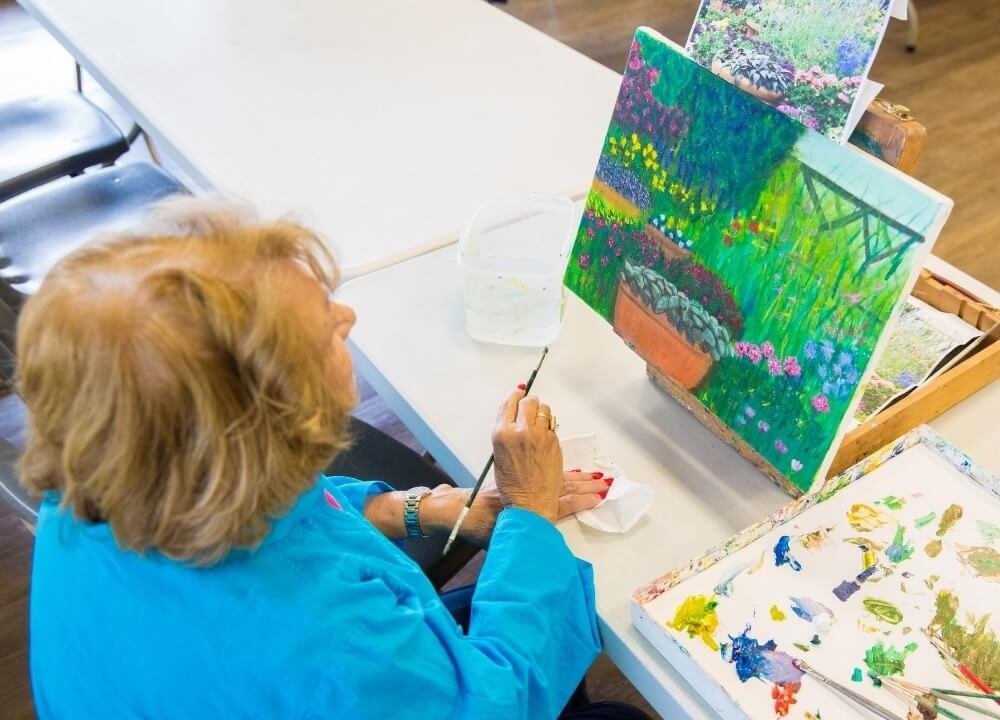Now, to be clear, viewing nature will not cure dementia. There are still no cures for most causes of dementia. But is there evidence that viewing nature improves dementia?
But what improves dementia’s symptoms improves dementia.
Science has proven time and again that viewing images of nature improves many factors that worsen dementia’s distressing symptoms.
Factors like pain, anxiety, depression and stress all impact dementia profoundly.
The Importance of Getting Outside, Nature & Dementia
These types of excess disabilities make it harder for people with dementia to function at their best. They can increase confusion, agitation, restlessness and impact sleep.
Unfortunately, when any one of these things falls out of balance it will often disrupt the others as well.

For example, if someone feels anxious it can impact their sleep.
- When sleep is disturbed, fatigue increases.
- As fatigue increases, the ability to think, function and process information decreases.
- This can easily lead to an increase in anxiety, agitated behavior and/or restlessness.
- Restlessness can contribute to falls, injuries and pain.
- Pain can lead to more restlessness, sleep disturbance, medication, anxiety and greater fall risk.
- Medication can lead to constipation which can lead to increased restlessness, sleep disturbance, agitation, anxiety and appetite loss.
- Appetite loss can lead to weight loss, weakness, decreased functioning and falls.
Symptoms can quickly spiral out of control and it can be hard to untangle the causes from the effects.
To the extent possible, a key goal in dementia care is to reduce “causes” and minimize effects.
So, when science shows us that viewing plants and scenes of nature can alleviate pain, anxiety, depression and stress we can see how this will effectively improve the symptoms of dementia – although more accurately we’re reducing excess disabilities that worsen dementia’s symptoms thereby allowing the person to function closer to their true baseline capability.
Hospitals are great places to study pain, stress and anxiety

Hospital patients, with their detailed records and controlled experience, are great fodder for study.
Hospital stays and procedures are known to be stressful, and contribute to anxiety. This makes them a great way to study the effects of plants on health outcomes, and there is no shortage of such studies.
View Through a Window May Influence Recovery from Surgery
One of the most cited studies occurred in1984 when Roger Ulrich examined whether the view through the window made a difference to the recovery of post-surgical patients.
Some rooms in the hospital overlooked a grove of trees, while others overlooked a brick wall. The rooms were nearly identical other than the view.
Patients went through the same gallbladder surgery and were matched on multiple factors, including age, gender, and health status.
The findings showed a statistically significant difference in:
1. The frequency and strength of pain medication required
The tree-view group required significantly less, and less potent, pain medication than the control group.
2. Length of hospital stay
The tree-view group was able to leave the hospital an average of a full day earlier than the brick wall-view group.
3. Fewer “negative” experiences
Nurse notes were reviewed for all patients. The group with the brick wall-view had over 3 times as many negative notes (such as “upset and crying” or “needs much encouragement” than the tree-view group who had more positive notes (like “In good spirits” and “moving well”).
Since 1984, thousands of studies have built on and expanded Dr. Ulrich’s research into an enormous body of research.
Although it wouldn’t be possible to cover them all here, we can take a closer look at a sampling of key studies.
Measuring the Benefits of Indoor Plants and Flowers

Live plants enhance health outcomes of patients recovering from surgery
In 2009, this study showed that post-surgical patients in hospital rooms with plants and flowers had a significantly improved physiological recovery response and felt better about their rooms and the hospital staff caring for them.
90 patients recovering from the same hemorrhoid surgery were randomly assigned to similar rooms either with or without live plants.
Researchers measured patients’ vital signs, length of hospital stay, pain medication used, ratings of pain intensity, distress, anxiety and fatigue.
They found that patients in rooms with live plants showed significantly lower systolic blood pressure, and less pain, stress, anxiety and fatigue than the control group.
They also rated their room satisfaction higher and reported more positive impressions of the hospital care staff.
Live plants enhance recovery and mood; reduce pain, anxiety and fatigue
This study in 2016 shows multiple benefits of live plants to post-surgical patients’ mood and recovery.
Patients in rooms with plants reported less pain, anxiety and fatigue than those in the control group.
They also were noted to have increased mood, social activity, friendly behavior towards others, and positive feelings in general.
They described their rooms to be more calming, soothing and satisfying than the control group.
There are hundreds of more studies showing similar effects of plants and flowers on health, stress, anxiety, pain and mood.
A number of studies examine the effect of simply viewing fresh-cut flowers or live plants in a room.
Viewing fresh flowers invokes relaxation and improves mood
Researchers in 2014 confirmed physiological and psychological relaxing effects of cut fresh roses in a room.
This study from 2016 also confirmed that the presence of flowers can positively influence mood as well as perceptions of places and other people.
In another study in 2017 researchers measured a significant relaxation response after participants viewed fresh roses for three minutes. The control group viewed no stimulus.
The physiological and psychological relaxation response was determined by measuring participants’ oxyhemoglobin levels, heart rate and heart rate variability.
A mood profile and semantic differential were also used, which showed a significant elevation in mood and an increase in feeling ‘natural’, ‘comfortable’ and ‘relaxed ’.
And, in case you had any doubt: receiving flowers is actually scientifically proven to enhance mood! It also enhances both social behavior and memory.
Receiving flowers improves mood, social behavior and memory
A series of studies in 2005, showed that people benefit in multiple ways from receiving flowers. People were presented with either flowers or a non-flower gift such as pens, candles or fruit.
The control gifts all had the same economic value, a pleasant odor, similar color variation and were wrapped similarly for presentation.
The results showed that that both women and men, young and old, showed improved mood, positive social behaviors and episodic memory after receiving flowers.
The social behaviors that were measured included initiation of conversations, eye contact, and standing at a more familiar social proximity. Non-flower gifts elicited less or no improvement in these areas.
These improvements were measured both immediately and weeks later, demonstrating a lasting effect on mood, social behavior and memory.
Live plants induce relaxation
In 2016, researchers studied men performing the same task – transferring pots for three minutes – with and without plants present. When live plants were present, the participants relaxed.
This was determined by significant differences in key physiological and psychological measurements, such as prefrontal cortex activity, heart rate variability and mood profile.
Images of Nature on Screens are also Effective

Viewing nature imagery on a screens induces relaxation and positive emotional response
In 2007, researchers found that individuals felt significantly less stressed, more friendly, playful and elated, and less fearful after viewing slide images of nature rather than urban scenes.
In 2018, researchers found significant evidence that viewing forest imagery induces physiological and psychological relaxation. Participants viewed images of either a forest landscape or a cityscape on a high definition television set.
After viewing forest imagery, participants’ oxyhemoglobin levels were decreased and they reported feeling much more “comfortable”, “relaxed” and “natural”.
Awe-inspiring images of nature can be especially potent
In 2014, researchers investigated whether there was any effect, or difference in effect, on people viewing mundane pictures of nature versus awe-inspiring scenes.
Images were shown on a computer screen and were grouped into three categories: awesome nature (such as grand mountain scenes or powerful storms), mundane nature (like grass, foliage or trees) and a control group (featuring objects like buckets, ladders or chairs).
Both types of nature images invoked significantly more feelings of being connected to others, feeling more caring and more spiritual than the control condition.
Both groups of nature images invoked an improved mood, more marked in the awesome images. The awesome images also lead to participants making more prosocial choices.
Photographs and Paintings of Nature can Reduce Stress and Improve Attention

Exposure to natural landscape art reduces anger and stress in males
A study in 2008 showed a significant reduction in anger and stress in males (but not females) when nature landscape art posters were displayed versus abstract art posters.
Participants were asked to perform frustrating tasks on a computer and then report their anger and stress levels.
In the natural landscape settings, the males in the experiment reported less stress and anger – the more natural landscapes were present, the less stress and anger was reported.
Viewing plants, or pictures of plants, reduces stress
In 2012, researchers found that people who viewed real plants and those who viewed images of plants experienced a reduction in stress as compared to the control group, which viewed none.
Viewing pictures of nature improves attention
In 2013, this study showed that viewing pictures of nature significantly improved executive attention in both older and younger adults, as opposed to pictures of urban scenes.
Viewing photos of natural scenery reduces impulsivity
In 2014, researchers concluded that exposure to photographs depicting natural scenery decreased impulsive decision making as compared to viewing photos of a cityscape.
Other Interesting Studies
Virtual reality nature experiences offer relaxation and stress relief
In 2019, researchers studied the effects of seven different simulated forest environments on stress relief and relaxation.
All the virtual reality environments proved to offer relaxing and stress-relieving effects.
The environment which included a prominent water feature was noted to be an especially powerful stress reliever.
Ceilings with sky images may support healthier dreaming and circadian rhythm
This 2014 study examined which differences in brain activity as measured by magnetic resonance imaging would be noted in hospital rooms with traditional ceilings and identical rooms which had sky images painted on the ceilings.
The rooms with sky compositions activated regions of the brain associated with spatial cognition, circadian rhythm, perceived motion and dreaming.
The plain-ceiling rooms activated regions related to facial processing and potential visual hallucinations.
Nature and Daylight Improves Mood and Reduces Stress
This 2018 study established positive effects of exposure to nature and daylight throughout everyday life on one’s mood and level of stress.
Viewing natural scenery promotes relaxation and enhances mood
In 2015, this study added to the body of evidence that seeing a natural forest landscape in person produced physiological and psychological relaxation and enhanced mood as compared to viewing an urban landscape.
Looking at a garden relieves stress and improves verbalization and memory in dementia
In 2018, researchers found that simply seeing a garden relieved physiological stress and improved verbalization and memory in people with advanced dementia.
The Conclusions are Clear: Viewing Images of Nature Improves Dementia

Study after study has added to the body of evidence: seeing plants or images of nature offers substantial benefits to people with dementia.
Whether it’s a photograph, a television program, a view through a window or seeing it live and in person, viewing nature is an effective way to enhance the quality of life for people with dementia.
It can reduce pain, anxiety and stress, promote relaxation, improve mood and enhance mental functioning in many ways.
Adding live plants or images of nature into the environment for someone with dementia is an effective, and low-cost way to help them function at their best.

![Viewing Nature Improves Dementia [Proven] viewing nature improves dementia](https://readementia.com/wp-content/uploads/2020/08/viewing-nature-improves-dementia.jpg)